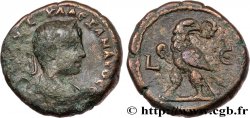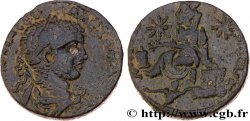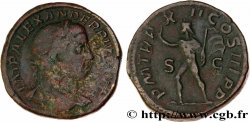bpv_941824 - ALEXANDER SEVERUS Assarion
Nicht verfügbar.
Artikel auf unserem Online-Shop verkauft (2024)
Preis : 60.00 €
Artikel auf unserem Online-Shop verkauft (2024)
Preis : 60.00 €
Type : Assarion
Datum: c. 222-235
Name der Münzstätte / Stadt : Périnthe, Thrace
Metall : Kupfer
Durchmesser : 18 mm
Stempelstellung : 12 h.
Gewicht : 2,36 g.
Seltenheitsgrad : R1
Kommentare zum Erhaltungszustand:
Exemplaire sur flan bien centré des deux côtés. Usure importante, mais parfaitement lisible et identifiable. Belle patine vert jade
Vorderseite
Beschreibung Vorderseite Tête laurée d’Alexandre Sévère à droite (o*).
Legende des Averses .AU K M AUR SE ALEXANDROS, (Autokrator Kaisar Markos Aurhlios Seuhros Alexandros)
Übersetzung der Vorderseite (L’empereur césar Marc Aurèles Sévère Alexandre).
Rückseite
Beschreibung Rückseite Urne agonisitique contenant une palme.
Legende des Reverses : (PE)RINQWN DIS NEWKO(RWN). (Perinqiwn Dis Newkorwn)
Übersetzung der Rückseite (de Périnthe deux fois décorée).
Kommentare
Périnthe était une colonie ionienne de Samos. Située entre Bisanthe et Selymbria, son monnayage débute au milieu du IVe siècle avant J.-C. Le monnayage fut important à l’époque impériale. La cité fut néocore une première fois sous Septime Sévère et une seconde fois sous le règne d’Élagabal. Sous les Antonins, nous avons parfois le nom du légat propréteur comme pour Gargilius Antiquus, “Legatus Augusti pro prætore provinciæ Thraciæ”.
Perinthus was an Ionian colony of Samos. Located between Bisathe and Selymbria, its coinage began in the middle of the 4th century BC. Coinage was important during the imperial era. The city was neocore the first time under Septimius Severus and a second time under the reign of Elagabalus. Under the Antonines, we sometimes have the name of the propraetor legate as for Gargilius Antiquus, “Legatus Augusti pro prætore provinciæ Thraciæ”
Perinthus was an Ionian colony of Samos. Located between Bisathe and Selymbria, its coinage began in the middle of the 4th century BC. Coinage was important during the imperial era. The city was neocore the first time under Septimius Severus and a second time under the reign of Elagabalus. Under the Antonines, we sometimes have the name of the propraetor legate as for Gargilius Antiquus, “Legatus Augusti pro prætore provinciæ Thraciæ”








 Berichten über einen Fehler
Berichten über einen Fehler Die Seite drucken
Die Seite drucken Teilen meiner Auswahl
Teilen meiner Auswahl Stellen Sie eine Frage
Stellen Sie eine Frage Einlieferung/Verkauf
Einlieferung/Verkauf
 Details
Details









